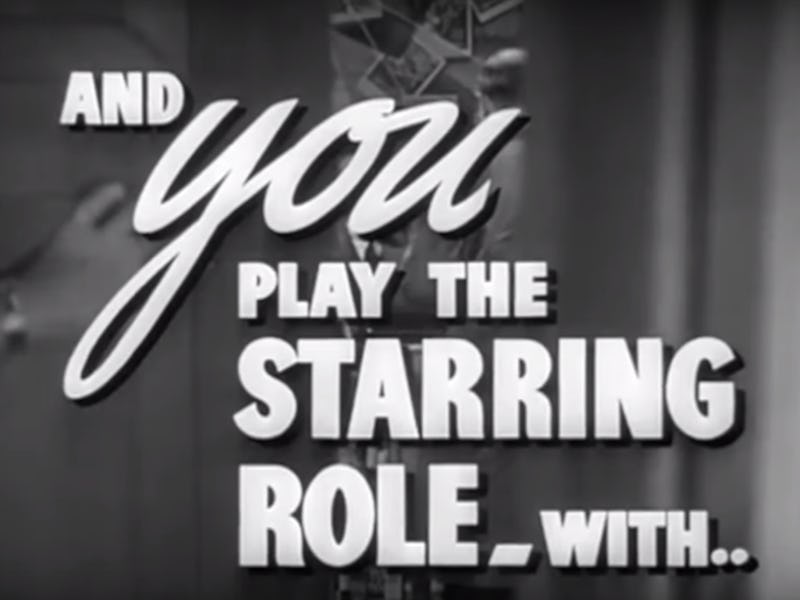'Hardcore Henry' is Definitely Not the First Hollywood First-Person POV Film
A 1947 Raymond Chandler adaptation was the first wide-release feature to put the audience in its hero's shoes.

It’s been a while since anything like Hardcore Henry hit the big or small screen. Relatively little functions at its post-Crank, roided-out, nauseating level of intensity, and it’s likely that you can’t name another film shot entirely in first-person POV. The third-eye vision of Gaspar Noe’s controversial, druggy 2009 epic Enter the Void only lingers inside the protagonist’s head for part of the film, and certainly, its Steadicam-heavy POV is smoother and more lethargic. Previous video game-y films, from DOOM to Shooter, have only dabbled in first-person perspective. Hardcore Henry’s jerky, GoPro-rendered visuals make for an intense, unremitting hour-and-a-half, and sure, there’s never been anything quite like it in the realm of wide-release feature films (we’ll discount Jonas Akerlund’s video for The Prodigy’s Smack My Bitch Up). But millions-grossing, first-person feature films are not a new thing; in fact, the first arrived in theaters 70 years ago.
Robert Montgomery’s 1947 film noir The Lady in the Lake was an adaptation of Raymond Chandler’s bestselling novel of the same name, and came in the midst of a period when the crime writers stories were being regularly made into box-office blockbusters. The previous year, Humphrey Bogart delivered the most iconic portrayal of Chandler’s beloved anti-hero “private dick,” Philip Marlowe, in Howard Hawks’ The Big Sleep, which despite being castigated by critics for being borderline incomprehensible (William Faulkner’s original screenplay was bent out of shape in edits, and the film was hacked to bits by the studio), was a major draw. Montgomery, who both directed and starred in The Lady in the Lake, decided to put his own spin on the popular detective by drawing the viewer into Chandler’s typically convoluted plot in a unique, albeit slightly corny, way. The action of the film was entirely shot from Marlowe’s perspective.
The only exceptions to the rule were a few explanatory asides. Addressing the camera for a few minutes at the beginning of the film, Montgomery, as Marlowe, explains that its concept: The viewer will “see [the mystery] just as I saw it,” he says. “Maybe you’ll solve it quick, and maybe you won’t…You’re smart.” Though there’s little first-person shoot-’em-up action (Marlowe rarely uses or carrying a gun in Chandler’s stories), the film is, in many ways, a “game” film, paced to give the viewer time to speculate about the mystery and felt more viscerally involved in the action.
The trailers advertised Montgomery’s technique as the next major innovation in film:
Montgomery pulls back out to Marlowe breaking the fourth wall a few other times to summarize the events of the film so far, and reiterate important clues to encourage the viewer to speculate about the murderer (or “murderess,” as they say upwards of ten times in the film). The computer-game-like effect is enhanced by extended scenes of Marlowe slowly creeping around houses at night and a long car chase which ends with “Game Over”-like camera work: rattling, rotating, and fading to black as Marlowe’s sedan tumbles into a ditch. There are also plenty of blow-by-blow fistfights; those who have read a Marlowe story or two know that he’s normally on the losing end of any punch, so a healthy portion of the film’s latter half is deliberately out-of-focus, as his head swims.
He does better with love interests than fights. The hard-boiled detective literature and films of this time — like so much else — are known for having exceptionally miserable gender politics. Yet even against so much competition, The Lady in the Lake stands on its own. Marlowe wins over the two major female characters in the film by insulting them and ogling at length. Thanks to the unrelenting first-person POV, Montgomery’s film gives new meaning to the concept of the “male gaze.” Of course, we get a money shot in which the film’s femme fatale lead, Audrey Totter, leans into to kiss camera-Marlowe, blacking out the screen entirely for a moment. In these ways, The Lady in the Lake may actually stand as a bro-ier film than Hardcore Henry.
These scenes in Lake are made all the more uncomfortable because of the actors oddly exaggerated facial expressions, and dramatic moments that seem staged almost at half speed. The acting is definitely adversely affected by the fact that the players are addressing a camera rather than a human being. Off-screen, Montgomery’s Marlowe — aside from the inevitable mirror-trick moments — delivers his lines with a barking deliberateness which is a far cry from Bogart’s sarcastic monotone, and doesn’t do Steve Fisher’s script any favors.
As many have with Hardcore Henry, ‘40s reviewers bemoaned the lack of well-realized characters, dialogue and twists in Montgomery’s film; there was simply not enough there to offset the gimmick. In subsequent decades, The Lady in the Lake became a cultural footnote, and one imagines Hardcore Henry will go the same way. Given how obscure the Chandler adaptation is today, many may remember Henry as the first culturally significant first-person feature. But does it really pose any kind of interesting vision of the future of cinema? Sure, half the world may be walking around with Oculus headsets on in a couple of years, and perhaps, in some ways, Henry will be considered prescient in evoking this reality in narrative film. But if Lady in the Lake is any kind of precedent, action film will not be revolutionized by Henry. A New York Times critic speculated that Montgomery had hit upon a way of using the camera which would change the future of cinematography; yet, that never really happened. Lady in the Lake’s vision never made a splash in Hollywood until — inadvertently, no doubt — now.